European Union funding in Scotland
This briefing provides information on European Union funding programmes in Scotland at present. It also details some of the guarantees and proposals made for replacement funding after Brexit.
Executive Summary
All EU Member States make contributions to and receive funding from the European Union budget. This process is governed by an agreement called the Multi-annual Financial Framework (MFF). The current framework covers seven years, from 2014 to 2020.
Scotland's public sector makes an annual net notional contribution to the EU budget of £455 million (based on a four year average). This represents roughly 0.6% of total public sector expenditure for Scotland in 2017-18. Money that comes directly from the EU to Scottish organisations in the private sector (including universities) is not included in this calculation.
Funds received from the EU's budget are of broadly two types: pre-allocated and competitive. Finance in the form of European Investment Bank Group lending is also significant and distributed outwith the EU budget.
Common Agricultural Policy (CAP) is by far the largest source of EU funds. Over £500 million a year comes to Scotland from the CAP in the form of direct payments to farm businesses and rural development funding. Following Brexit, short-term guarantees have been provided by the UK Government to replace most CAP funds until 2022, but no commitments have yet been made to replace CAP funding in the long term.
Structural Funds in Scotland are worth up to €941 million across the EU budget period for use in economic development. To make full use of these funds, they must be legally committed to projects in Scotland by the end of 2020. Half of Scotland's potential structural funding is uncommitted at present. Following Brexit, the UK Government has provided short-term guarantees and proposes a UK-wide replacement fund in the longer-term.
Common Fisheries Policy is co-financed in Scotland through the European Maritime Fisheries Fund (EMFF). Scotland is allocated 44% (€108m) of the total UK figure and £42 million - over 80% of the Scottish allocation - has been committed to projects so far.
Competitive funds are awarded directly by European Commission to organisations and include significant research, innovation and education exchange programmes. Since 2014, €533 million of Horizon 2020 funding, €65 million of Erasmus+ funding and €58 million of Territorial Cooperation funding has been secured by Scottish organisations.
The European Investment Bank Group provides finance outwith the MFF 2014-20 in the form of loans. Since 2016, the EIB has signed loans worth €2.0 billion to projects in Scotland.
Introduction
On 23 June 2016, the UK voted to leave the European Union (EU). However, at present the UK remains a Member State and therefore continues to make contributions to the EU budget and to receive EU funding through various channels. UK-EU negotiations on the terms of Brexit and any transition period are ongoing.
The outcome of negotiations will dictate short-term future access to EU funding for Scottish organisations. The negotiations will also influence any longer-term UK replacement programmes or the possibility of participation in some EU programmes and any corresponding financial contributions.
This briefing is designed to inform discussions on the replacement of EU funding programmes in Scotland when the UK leaves the EU.
This briefing sets out:
How EU funding currently works, and how much comes to Scotland.
Scotland's net contribution to the EU budget.
Options to replace EU funding programmes or continue to participate in them.
The European Union Budget
All EU Member States make contributions to and receive funding from the European Union budget. This process is governed by a multi-year agreement called the Multi-annual Financial Framework (MFF).
The MFF is not a budget spanning several years, but rather it provides a framework for financial programming and budgetary discipline. It aims to ensure that EU spending is predictable and stays within the agreed limits, while also allowing the EU to deliver common policies over an extended period.
The current MFF runs from 2014 to 2020 (seven years) and defines a maximum spend ('ceiling') across Europe of €960 billion. This spending is equivalent to around 1% of the Gross National Income (GNI) of the whole EU.1 Annual budget ceilings are set out for six broad headings of expenditure:
Smart and Inclusive Growth (47%)
Sustainable Growth: Natural Resources (39%)
Administration (6%)
Global Europe (6%)
Security and Citizenship (2%)
Compensations (<1%)
The percentage figures represent spending as allocated by the 2014-2020 MFF.
The MFF is financed by Member States in three different ways:
Customs duties on imports from outside the EU and sugar levies.
A uniform rate of 0.3% levied on the harmonised value added tax (VAT) base of each Member States.
Each Member State transfers a standard percentage of its GNI to the EU. The GNI-based contribution is the largest part of each member state's payment and is set each year by the EU to balance the budget.
The MFF finances most European funding programmes. Funding programmes are of broadly two types:
Pre-allocated funds where each Member State is apportioned an amount depending on their circumstances. Examples of pre-allocated funds include the European Social Fund and funding for the Common Agricultural Policy. The formula for allocating these funds to the Member States is agreed at the outset of the MFF. Pre-allocated funds cover over 76% of the EU budget and are dispersed in partnership with national and sub-national authorities.
Competitive funds allocated directly by the European Commission. Examples of competitive funds include Horizon 2020 and Erasmus+. To access this funding, Scottish projects, or projects involving Scottish stakeholders, need to bid against other projects across the European Union.
In addition to funding distributed as part of the MFF, some finance is provided outwith the EU budget to projects in Scotland on a more commercial basis:
European Investment Bank (EIB): the EIB is an investment bank that is jointly owned by EU Member States and is the world's largest multilateral lending institution.
European Investment Fund (EIF): the EIF is a specialist provider of risk finance to small and medium-sized enterprises (SME) across Europe.
Scotland's net contribution to the EU budget
As a member of the EU the UK contributes to the EU budget (and receives funding). The Scottish Government does not contribute directly to the EU budget. However, it is possible to provide a notional figure for Scotland's contribution. This calculation has been carried out by the Scottish Government in their most recent publication of Government Expenditure and Revenue Scotland.
| 2014-15 | 2015-16 | 2016-17 | 2017-18 | |
|---|---|---|---|---|
| Gross contribution to the EU budget | 1,144 | 1,121 | 987 | 1,039 |
| Public sector EU receipts (not including private sector receipts, e.g. Higher Education Institutions) | -606 | -551 | -702 | -613 |
| Net contributions to EU budget | 538 | 570 | 285 | 426 |
Scotland's notional net contribution (not including private sector receipts) averaged across the last four financial years of available data is £455 million, representing roughly 0.6% of total public sector expenditure for Scotland in 2017-18.
Payments from the EU to private sector organisations are not included in the notional figures reported above. As noted in Table 1, higher education institutions (HIEs) are considered to be private sector not-for-profit organisations. HIE receipts for research grants and contracts from EU government bodies were worth £79 million (2014-15), £82 million (2015-16) and £88 million (2016-17).1 These figures refer to academic years and do not include non-research funding, such as Erasmus+.
EU Funding Programmes 2014-20
The infographic and table overleaf summarise the most significant EU funding programmes which are available to Scotland and what will happen to the programmes after Brexit.
Funding programmes to deliver the Common Agricultural Policy make up the largest part of EU funding. They are marked in green.
The European Social Fund (ESF) and European Regional Development Fund (ERDF) are normally referred to informally as the Structural Funds. They are marked in orange.
The European Maritime Fisheries Fund (EMFF) is the financial component of the Common Fisheries Policy. This is marked in light blue.
The European Commission directly awards a large set of competitive funds, They are marked in charcoal.
The European Investment Bank Group provides finance outwith the MFF 2014-20. This is marked in dark blue.
The rest of this briefing will use the same groupings to explore these funds in more detail.
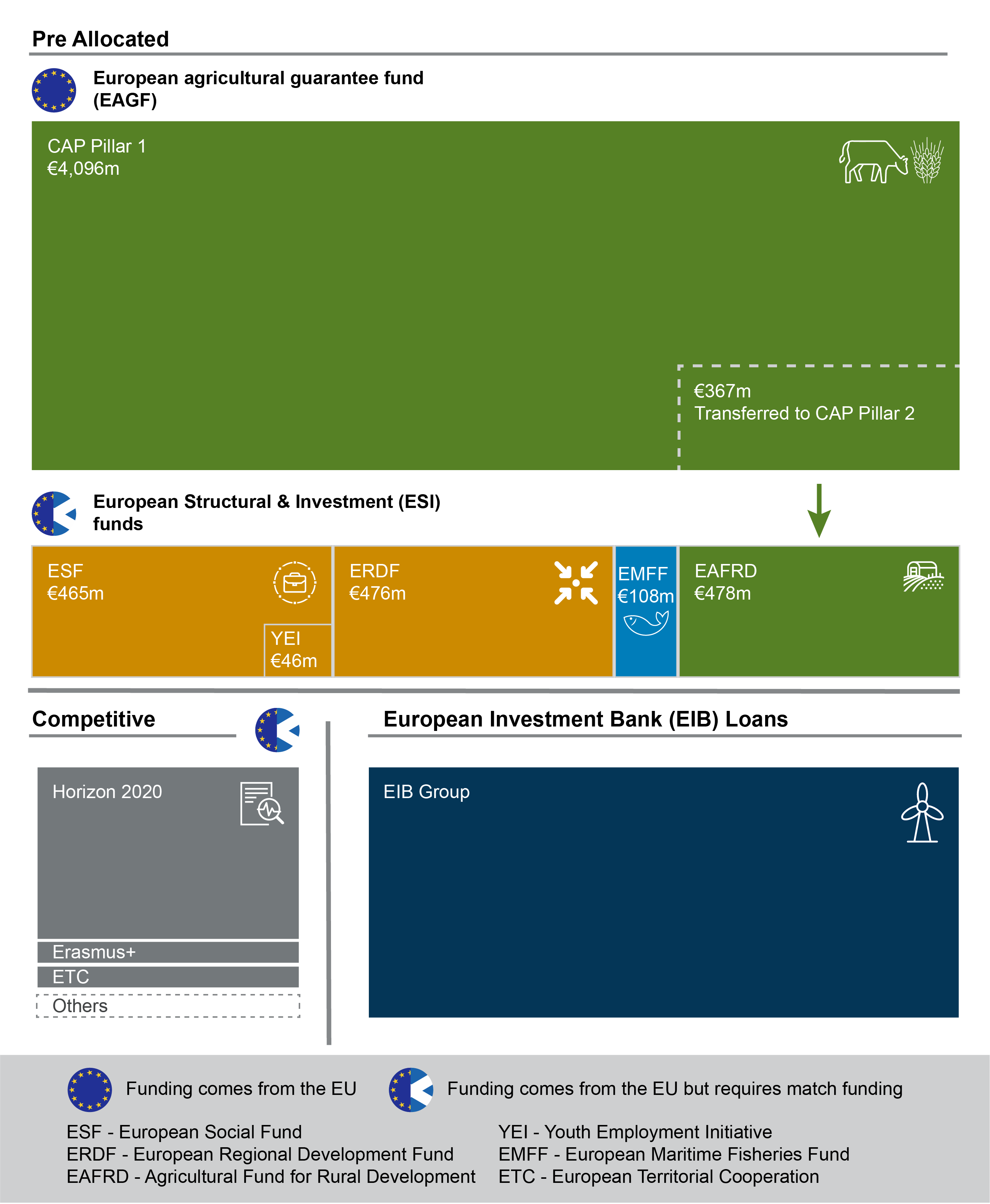
| EU funding programme | Funding status by exit scenario | UK Government replacement plans | |||
|---|---|---|---|---|---|
| Withdrawal agreement finalised | UK exits with no agreement | Short term (i.e. in a "no-deal" scenario) | Longer term | ||
 | CAP Pillar 1 - European Agricultural Guarantee Fund | Direct payments continue for the 2019 scheme year. | No access to EU funding for direct payments after March 2019. | The UK Government has pledged to fund farm support at the same cash total as at present. | No commitment yet made to replace CAP funding in the long term. |
 | CAP Pillar 2 - European Agricultural Fund for Rural Development | The current round of rural development funding (2014-20) will continue. | No access to EU funding for rural development projects after March 2019. | UK Government guarantee will allow Scottish Government to pay grants and sign new projects until the end of 2020. | No commitment yet made to replace CAP funding in the long term. |
  | Structural Funds - European Social Fund and European Regional Development Fund | The current round of structural funding (2014-20) will continue. | No access to EU funding for ESF and ERDF projects after March 2019. | UK Government guarantee will allow Scottish Government to pay grants and sign new projects until the end of 2020. | UK Government intends to replace structural funds with a UK Shared Prosperity Fund. |
 | European Maritime Fisheries Fund | The current round of EMFF funding (2014-20) will continue. | No access to EU funding for EMFF projects after March 2019. | UK Government guarantee will allow Scottish Government to pay grants and sign new projects until the end of 2020. | No commitments yet made to replace EMFF funding in the long term. |
 | Horizon 2020 | The current Horizon 2020 programme will continue. | Organisations may be unable to access EU funding for Horizon 2020 projects after March 2019. | Agreement with the European Commission will be required to allow for continued participation. The UK Government guarantee will underwrite existing projects and new projects if participation is possible. | UK Government intends to negotiate for UK participation in EU research funding programmes, including Horizon Europe. |
 | Erasmus+ | The current Erasmus+ programme will continue. | Organisations may be unable to access EU funding for, or participate in, projects after March 2019. | Agreement with the European Commission will be required to allow for continued participation. The UK Government guarantee will underwrite existing projects and new projects if participation is possible. | The UK Government is "open to exploring" participation in the successor scheme. |
 | European Territorial Cooperation | The current ETC programme will continue. | Organisations may be unable to access EU funding for, or participate in projects after March 2019. | Agreement with the European Commission will be required to allow for continued participation. The UK Government guarantee will underwrite existing projects and new projects if participation is possible. | No commitment made. |
 | European Investment Bank Group | UK projects will not be eligible for most finance options. | UK projects will not be eligible for most finance options. | No direct replacement suggested at present.UK Government policy is to expand domestic finance options. | Uncertain. UK Government may be intending to negotiate continued association with the EIB. |
Common Agricultural Policy
Common Agricultural Policy (CAP) is by far the largest source of EU funds for Scotland. Over £500 million a year comes to Scotland from the CAP. This source of funding will be lost once the UK leaves the EU.
Short-term guarantees have been provided by the UK Government to replace most CAP funds until 2022. No commitments have yet been made to replace CAP funding in the long term.
The Common Agricultural Fund at an EU level
The CAP aims to ensure a decent standard of living for farmers and to provide consumers with a stable and safe food supply at affordable prices.
The CAP is made up of two pillars with a combined EU-wide budget of €58.8 billion in 2018.1
Pillar 1 from the European Agricultural Guarantee Fund, provides:
€41.7 billion in direct payments to support farmers' incomes across the EU in 2018, and
€2.7 billion in market-support measures across the EU in 2018. An example of a market support measure would be purchasing milk powder when dairy prices are low and selling it when prices rise.
Pillar 2 from the Agricultural Fund for Rural Development provides
€14.4 billion to support rural development and environment related actions across the EU in 2018.
The European Parliament's Fact Sheet on Financing of the CAP describes the development of the financial framework.
How are CAP funds allocated across the EU?
For many years, allocation of budget between Members States had been based on past payments. However, in the 2014-2020 reforms the “external convergence mechanism” sought to reduce the link between historic payments and budget allocations. The European Council conclusions on the MFF say:
Direct support will be more equitably distributed between Member States, while taking account of the differences that still exist in wage levels, purchasing power, output of the agricultural industry and input costs, by stepwise reducing the link to historical references and having regard to the overall context of Common Agricultural Policy and the Union budget.
European Commission. (2013, February 8). European Council conclusions. Retrieved from http://europa.eu/rapid/press-release_DOC-13-2_en.htm [accessed 7 October 2018]
The European Council conclusions indicate some of the criteria used to allocate CAP funds to EU Member States. However, as the Institute for Fiscal Studies states, a specific formula is not available:
While the rules on how much farmers get in each country are generally published by the national governments, the actual rules for determining how much each country receives from the overall EU budget are not published. This is apparently in an effort to prevent the periodic negotiations of the CAP from getting bogged down in horse-trading. But it does mean that the process by which national allocations are determined is far from transparent.
Institute for Fiscal Studies. (2016, April). The budget of the European Union: a guide. Retrieved from https://www.ifs.org.uk/uploads/publications/bns/BN181.pdf [accessed 7 September 2018]
The European Commission's Multiannual Financial Framework 2014-2020 and the financing of the CAP document sets out how much each Member State receives from the European Agricultural Guarantee Fund (Pillar 1) and the Agricultural Fund for Rural Development (Pillar 2) in the current period.
How are funds allocated across the UK?
Over 2014-2020 the UK will receive €25.1 billion in Pillar 1 direct payments and €2.6 billion in Pillar 2 funds.1 The UK Government allocates this to the Department for Environment, Food & Rural Affairs (Defra) and the devolved administrations.
In November 2013, following intensive negotiations, the UK Government announced that farmers in England, Northern Ireland, Wales and Scotland would receive the same proportion of the UK's overall 2014-20 CAP budget as they had in the previous CAP programme. Owen Paterson, the then UK Secretary of State for the Environment said that the UK Government had worked closely with farmers and ministers across the devolved administrations to “make sure that this is fairly allocated across the UK”.1
Box 1: CAP distribution decisions
The decision to maintain the same distribution of CAP funding across Defra and the developed administrations was controversial in Scotland.3 The UK qualified for an uplift in its Pillar 1 budget from 2014-20 under the “external convergence mechanism”. The aim of the external convergence mechanism was to distribute direct payments more equally throughout the EU, based on average payments per hectare. The UK qualified for a £190 million uplift because Scotland had low payment rates per hectare, which brought the UK below the qualifying threshold.
Because the UK Government allocated the 2014-2020 CAP budget in the same way as it had in the previous programme, this uplift was shared between England, Scotland, Northern Ireland and Wales. Scotland has been allocated £30 million of the £190 million uplift.
At the time UK Government explained this on the basis that Scotland received more funding per farm than other parts on the UK.4 The Scottish Government continues to argue that “£160 million in CAP funding [is] owed to Scottish hill farmers”.5 The UK Government had agreed to conduct a review of the settlement. However, it has informed the Scottish Government of an open-ended delay to this review.5 It is now unclear if or when this review will take place.
How much CAP funding does Scotland get?
Scotland was allocated €4,096 million of Pillar 1 funds and €478 million of Pillar 2 funds for the CAP programme 2014-2020.1 The represents around 17% of the total UK CAP budget.
EU regulations permit the transfer of funds from Pillar 1 to Pillar 2. The Scottish Government chose to transfer 9.5% of the Pillar 1 budget to Pillar 2. In financial year 2014, pillar to pillar transfers were slightly lower as they were determined under the old regulations. A total of €367 million has been transferred from Pillar 1 to Pillar 2 for the 2014-2020 period. Scotland therefore has a Pillar 1 budget of €3,729 million over the financial years 2014-2020.
Pillar 2 funding in Scotland supports the Scottish Rural Development Programme (SRDP). This is funded over the 2014-2020 period by:
€478 million from the European Agricultural Fund for Rural Development (EAFRD)
€367 million from a 9.5% transfer of Pillar 1 funds
€675 million from the Scottish Government. The Scottish Government component reduced in 2017 when the Scottish Government revised the SRDP.2 Originally, the Scottish Government component had been €838 million.3
Figure 2 shows how Scotland allocates its CAP funds and how much is allocated to the different Pillar 1 and 2 schemes.
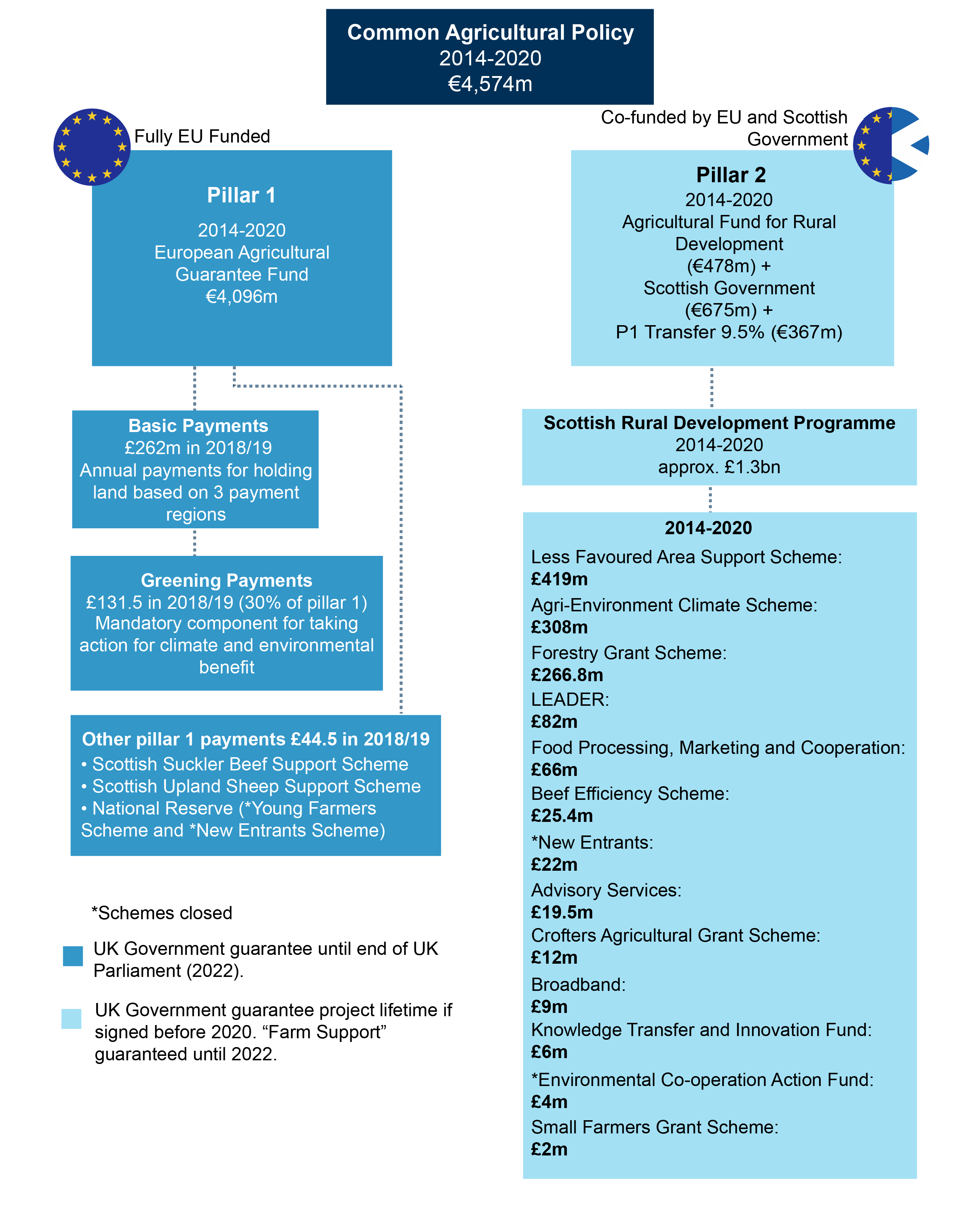
Assumptions have been made in colour coding the post-Brexit funding guarantees in Figure 2, due to uncertainties around the exact meaning of the guarantees - see below.
Where does CAP funding go within Scotland?
Different regions of Scotland receive different amounts of CAP funding. Any change in policy will affect regions differently.
The UK CAP payments website provides details of amounts received by UK beneficiaries under the CAP. Steven Thomson of Scotland's Rural College (2018) used this data to show total payments for 2017 by postcode district in the maps below for Pillar 1 and Pillar 2. In both cases the darker, browner colours show higher levels of funding.
The first two maps can be compared against farm types shown in Map 3.

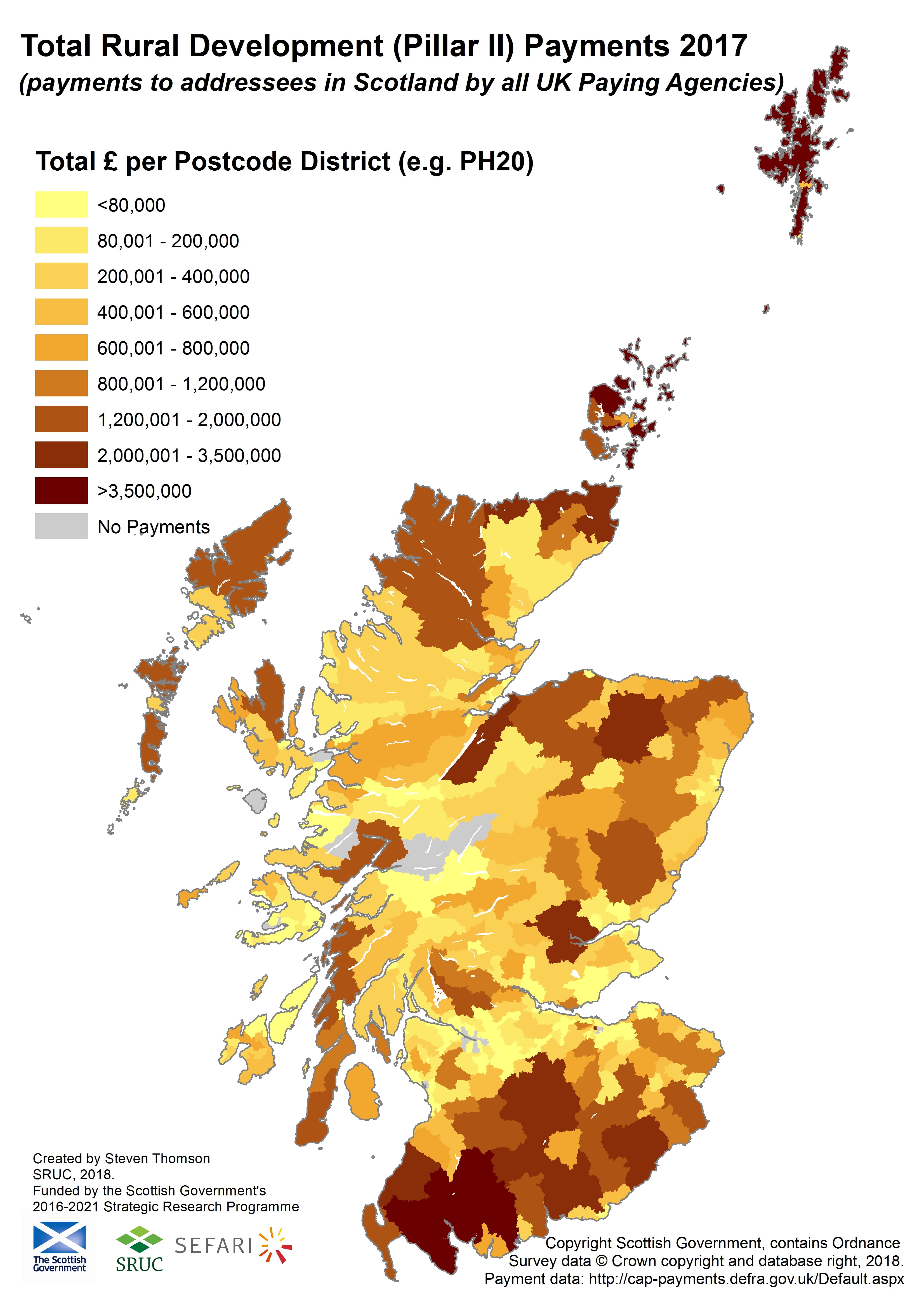
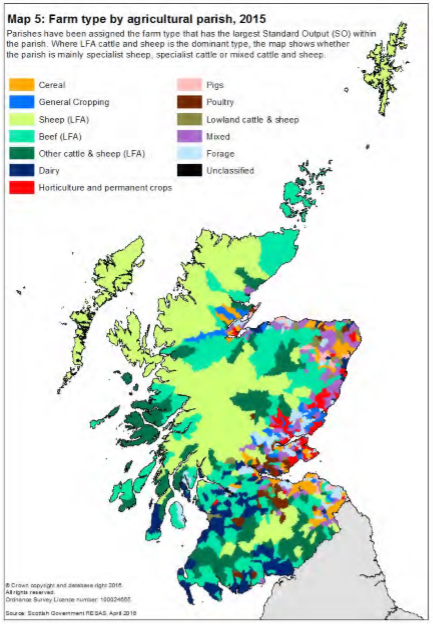
Matthews et al from the James Hutton Institute (2017)1 analysed the 2015 CAP Pillar 1 reforms, including modelling how much Pillar 1 and LFASS funding will go to different areas of Scotland. Figure 3 shows the amount of funding each area will receive and the number of farming businesses in that area. This shows that North East Scotland is projected to receive the most Pillar 1 and LFASS funding in 2019.
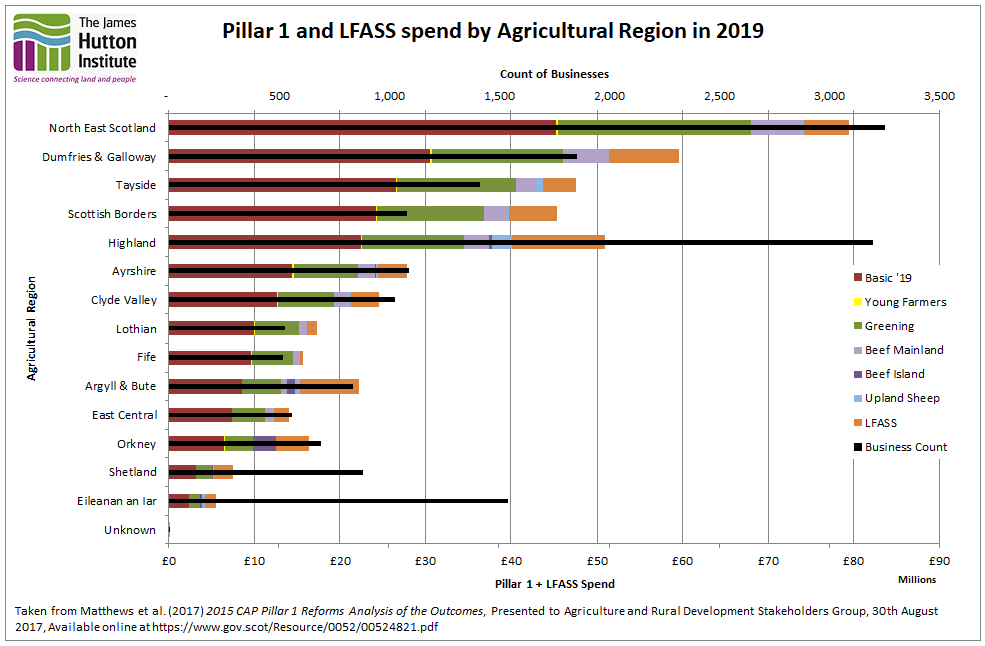
Funding for agricultural policy after Brexit
Withdrawal Agreement
If the terms of the proposed Article 50 Withdrawal Agreement are agreed, most EU law will continue to apply in the UK until the end of December 2020. All Pillar 1 and 2 regulations will continue to apply with the exception of the EU basic payment regulation, which applies until the 2019 scheme year.
"No-deal" planning
On 23 August 2018, the UK Government published two farming related technical notes on preparations for a "no-deal" Brexit (where the UK leaves the EU without finalising a withdrawal agreement):
These notes repeat guarantees about CAP funding given previously. There are two main funding commitments.
1. "the government has pledged to continue to commit the same cash total in funds for farm support until the end of this parliament, expected in 2022: this includes all funding provided for farm support under both Pillar 1 and Pillar 2 of the current CAP. This commitment applies to the whole UK."
This seems to guarantee Pillar 1 funds to 2022 although there are at least 3 issues that are unclear:
What is meant by "farm support"? And which Pillar 2 schemes are considered farm support?
What is meant by "the same cash total… until 2022"? And how does this relate to the allocation of CAP funds by the UK Government for 2014-2020?1
What is meant by 2022 - i.e. scheme year, calendar year, financial year?
2. "the UK government has guaranteed that any projects where funding has been agreed before the end of 2020 will be funded for their full lifetime … The guarantee also means that Defra and the devolved administrations can continue to sign new projects after the UK leaves the EU during 2019 and 2020, up to the value of programme allocations."
This seems to guarantee all Pillar 2 funds to the same extent that they are guaranteed now under EU law and the MFF 2014-20.
The current CAP programme ends in 2020 and a new programme is being developed, without the UK's participation.
Longer-term funding
No announcement has been made about long term funding for UK agriculture outside the EU and the CAP.
On 23 August 2018, the Scottish Government's Cabinet Secretary for the Rural Economy, Fergus Ewing stated "During the referendum, promises were made to farmers that they would continue to receive at least the same level of funding as they currently do in the event of Brexit… These papers [the technical notes] fail to confirm that this will indeed happen".2
However, in the Rural Economy and Connectivity Committee on 27 June 2018, Mike Rumbles MSP asked the UK Government's Secretary of State for Environment, Food and Rural Affairs, Michael Gove, "Is it your intention to ensure that we [Scotland] continue to receive that 16 per cent level of funding and that it will be ring fenced and protected so that it cannot be spent outwith the rural economy?"
Michael Gove stated "Absolutely. In a nutshell—yes."3
Structural Funds
The structural funds support economic development across all EU countries and are intended to promote smart, sustainable and inclusive growth.
In Scotland, the structural funds are composed of two similar sized funds: the European Regional Development Fund (ERDF) and the European Social Fund (ESF).
How are funds allocated across the EU and UK?
Structural funds are distributed to Member States according to a EU-wide formula based on economic performance (GDP per person) in regions within Member States. The regions are NUTS 2 regions, which split Scotland into four (see Map 4).i
The EU-wide formula favours NUTS 2 regions with less GDP per person.1 As a result, funding is not evenly distributed across the UK, but Member States are allowed to shift funds between regions (see Box 2).
Across 2014-20 Scotland has been allocated a maximum of €476 million from the ERDF and €465 million from the ESF.2 In addition, a further set of funding programmes exist under the ERDF for cross-border cooperation projects.
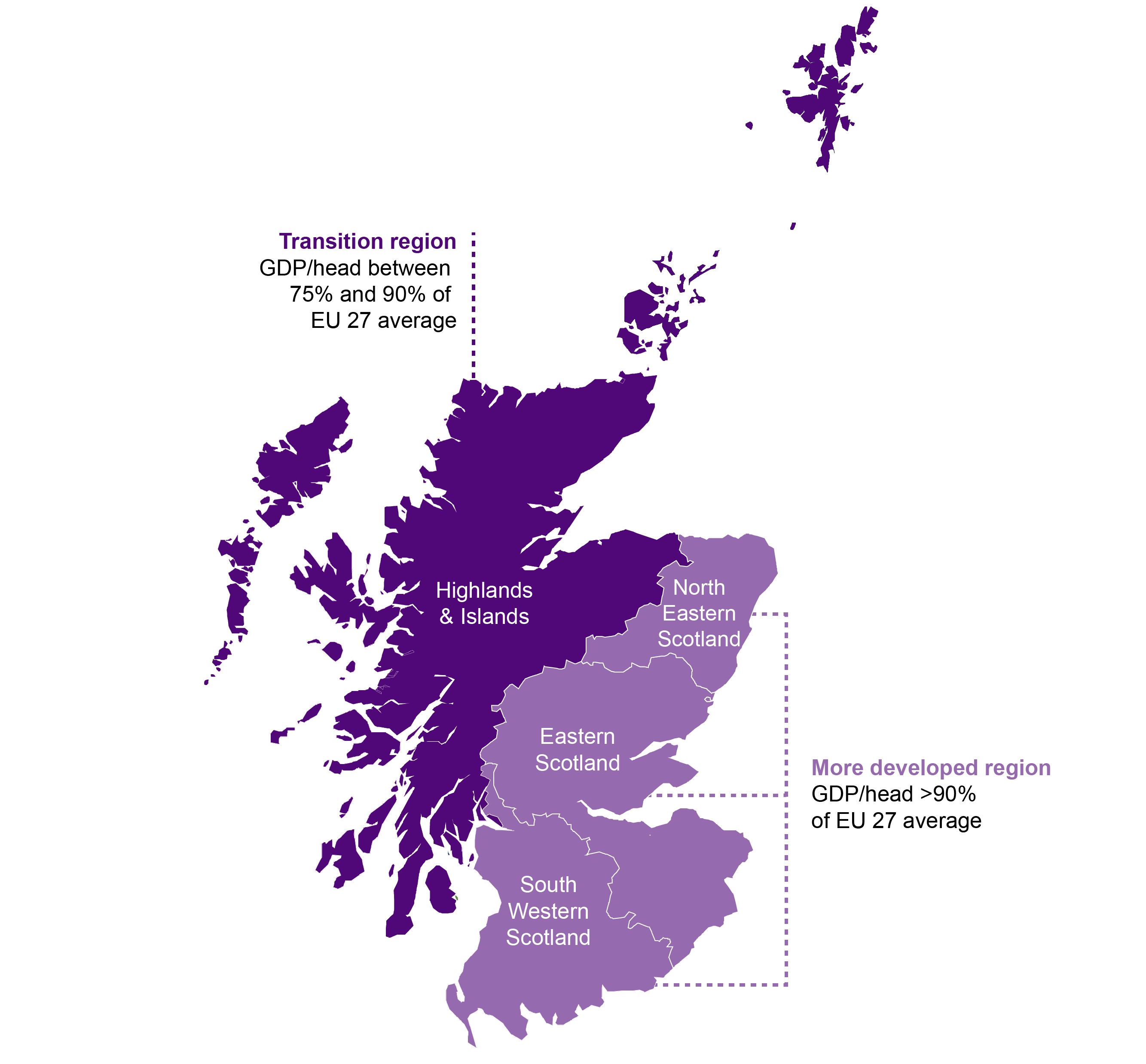
Box 2: decisions to deviate from the EU distribution formula3
The formula for distributing structural funds to NUTS 2 regions under the MFF 2014-20 would have resulted in an increase in funding for England relative to the previous period (of around 9% [nominal terms]) and a sharp reduction in funds for the devolved administrations (of between 20% and 40%). This was due to some regions in England tipping over into the category of regions eligible for greater funding, under the new rules. To re-balance the situation the UK Government sought to deviate from the EU framework and reallocate money that would have gone to England to the devolved administrations. The UK Government announcement in March 20134 describes Scotland receiving “an uplift of €228 million compared to the amount that Scotland would receive under the EU formula”.
How decisions on structural funding are made
The process starts with the EU regulations setting out the programme rules, along with some high-level targets. The Commission and the Member States then agree a partnership agreement defining how the suite of European Structural & Investment (ESI) funds will be spent and the types of activity that can be funded.
An Operational Programme (one for each fund) sets out in detail the level of funding available for different types of activity for the whole programme period.
The next stage is to develop Strategic Interventions which identify a cohesive set of activities, fronted by a lead partner, and allocate a maximum budget.
Finally, individual Operations describe the point when funding for individual projects becomes legally committed and money can be drawn down from the EU.
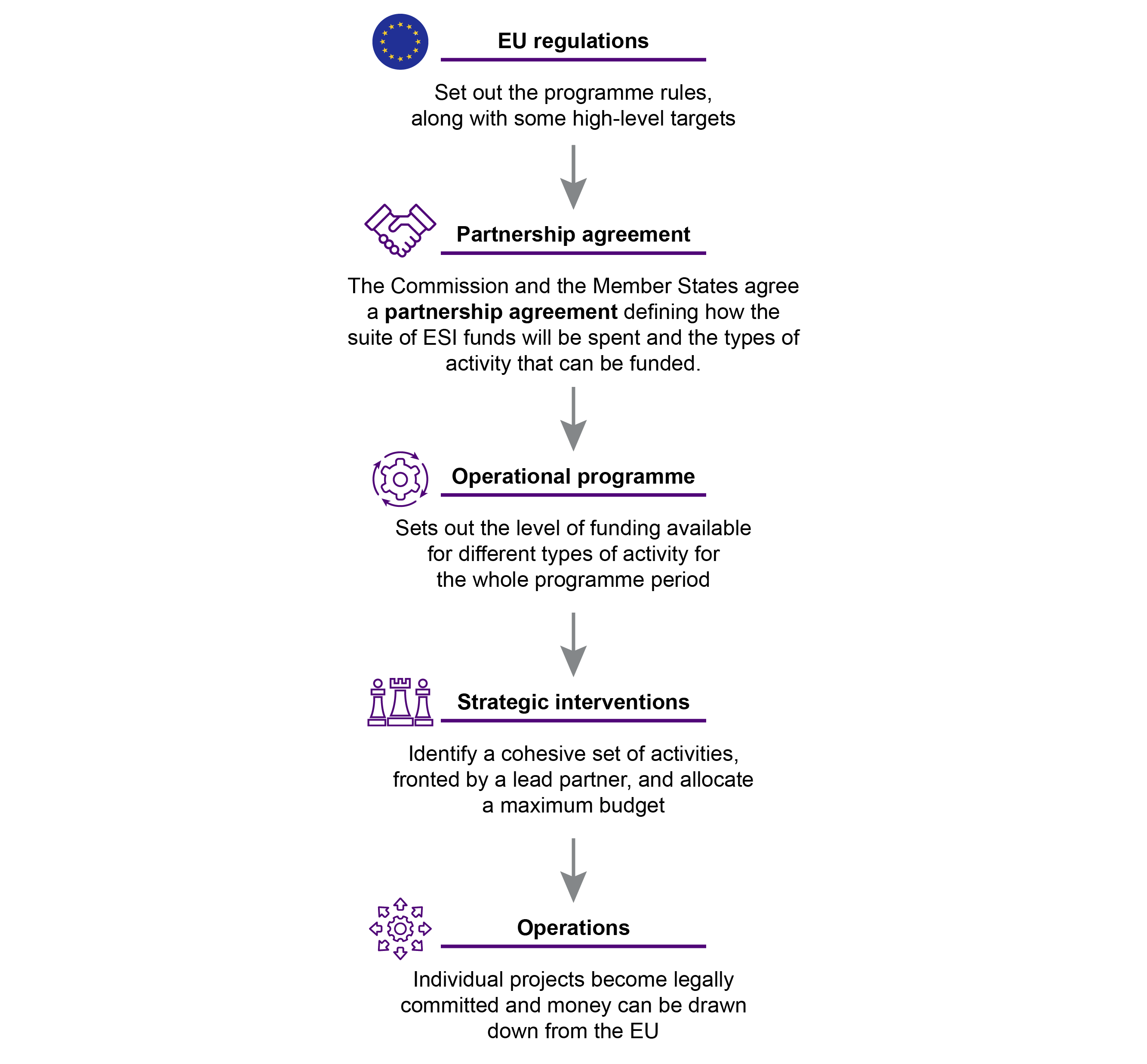
Structural funds in Scotland today
The UK's Partnership Agreement published in 20141 includes a chapter authored by the Scottish Government which covers both structural funds. The Partnership Agreement defines the Scottish Government as the Managing Authority for both structural funds. As the Managing Authority, the Scottish Government has agreed operational programmes for both the ERDF and ESF with the European Commission.2
In line with its operational programme, the Scottish Government allocates funds to Lead Partners through Strategic Interventions. Lead Partners are often the organisations taking the lead on behalf of a group of partners. They will usually spend and claim a significant proportion of the structural funds directly, but may also distribute some of the funding to other partners.
As shown in Table 3, Lead Partners can be Government policy directorates, agencies and local authorities with the capacity and capability to manage the funds and provide match funding of their own. They usually have significant and existing policy and funding presence in the area. Funding is split between two Programme areas: Highlands and Islands (accounting for around 20% of total funding), and Lowland and Uplands Scotland (essentially the rest of Scotland).
| Lead partner | Number of Strategic Interventions | Value of allocation (£) |
|---|---|---|
| Scottish Government | 7 | 186,588,094 |
| Scottish Funding Council | 3 | 82,195,053 |
| Skills Development Scotland | 2 | 77,243,700 |
| Scottish Enterprise | 2 | 37,337,093 |
| Zero Waste Scotland | 2 | 30,725,000 |
| Transport Scotland | 1 | 25,000,000 |
| Scottish Natural Heritage | 2 | 24,393,000 |
| Glasgow City Council | 4 | 21,003,467 |
| Highlands & Islands Enterprise | 2 | 16,434,000 |
| North Lanarkshire Council | 3 | 9,248,262 |
| South Lanarkshire Council | 3 | 7,351,676 |
| Big Lottery Fund | 1 | 7,333,333 |
| Highland Council | 3 | 7,175,888 |
| North Ayrshire Council | 4 | 5,998,888 |
| Fife Council | 3 | 5,313,080 |
| East Ayrshire Council | 4 | 5,224,399 |
| Renfrewshire Council | 4 | 4,927,037 |
| West Lothian Council | 3 | 4,751,289 |
| City of Edinburgh Council | 2 | 4,656,828 |
| Dumfries & Galloway Council | 4 | 4,246,272 |
| Aberdeenshire Council | 3 | 3,910,688 |
| Dundee City Council | 2 | 3,360,000 |
| Falkirk Council | 3 | 3,022,132 |
| West Dunbartonshire Council | 4 | 2,434,974 |
| Perth & Kinross Council | 2 | 2,249,500 |
| Inverclyde Council | 2 | 1,695,500 |
| South Ayrshire Council | 2 | 1,690,386 |
| Moray Council | 2 | 1,406,993 |
| Aberdeen City Council | 2 | 1,395,600 |
| Scottish Borders Council | 2 | 1,305,519 |
| Stirling Council | 2 | 1,129,500 |
| Comhairle nan Eilean Siar | 3 | 1,122,500 |
| East Lothian Council | 1 | 929,500 |
| Orkney Islands Council | 3 | 905,000 |
| Midlothian Council | 2 | 769,617 |
| Clackmannanshire Council | 1 | 622,222 |
| Shetland Islands Council | 2 | 620,021 |
| East Renfrewshire Council | 1 | 588,500 |
| East Dunbartonshire Council | 2 | 486,826 |
| Argyll & Bute Council | 1 | 298,762 |
| Total | 101 | 597,090,099 |
Structural funds flow into the complex landscape of economic development. It is not straightforward to track the ultimate recipients of the funding. However, data is available on the funding provided to Delivery Agents.
Delivery Agents are often the same organisations as Lead Partners, but at this point funding has been legally committed to specific operations. The top Delivery Agents by value of operations are shown in Figure 6. The final beneficiaries of operations will be either businesses, third sector groups or individuals seeking to improve their skills.
All structural fund supported projects (i.e. operations) require co-financing from either public or private sources; the average rate of EU funding for operations in Scotland is 44% (42% for ERDF and 46% for ESF).
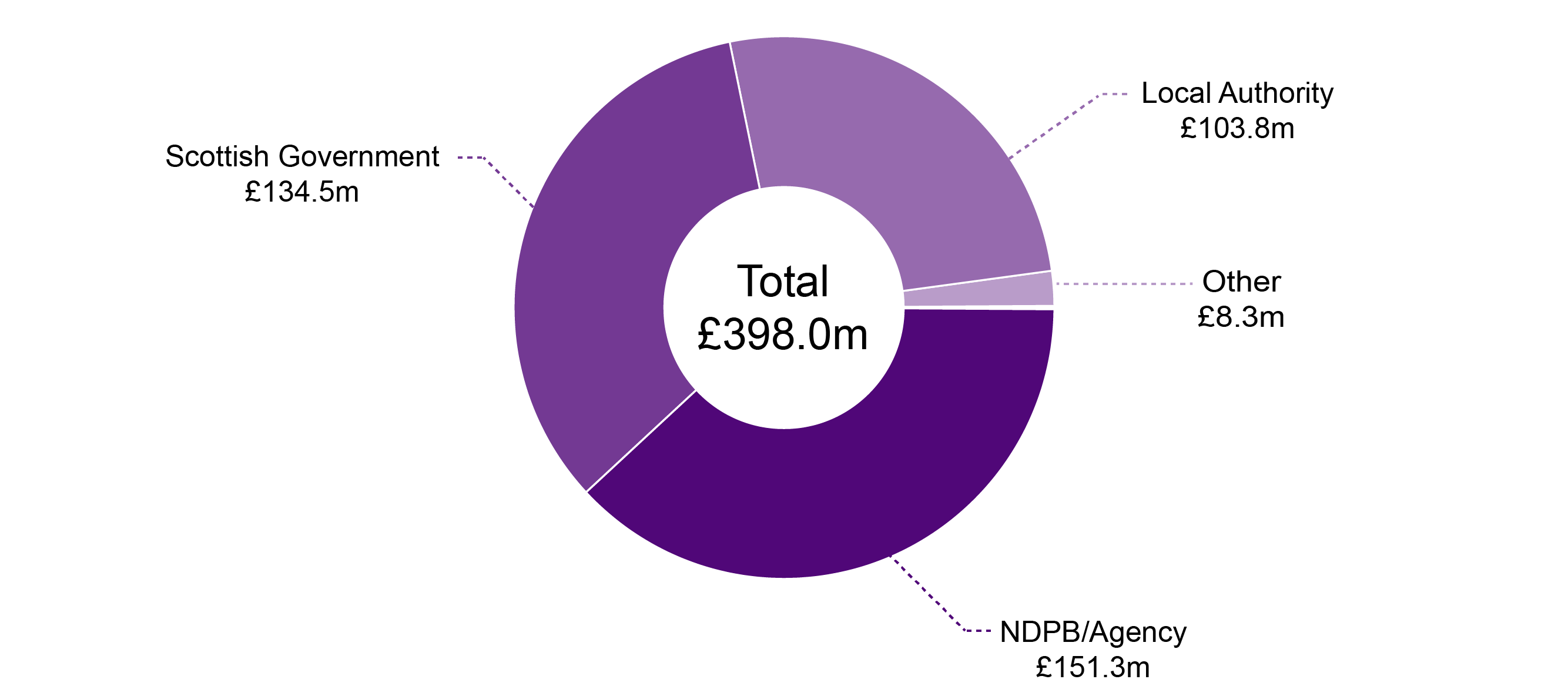
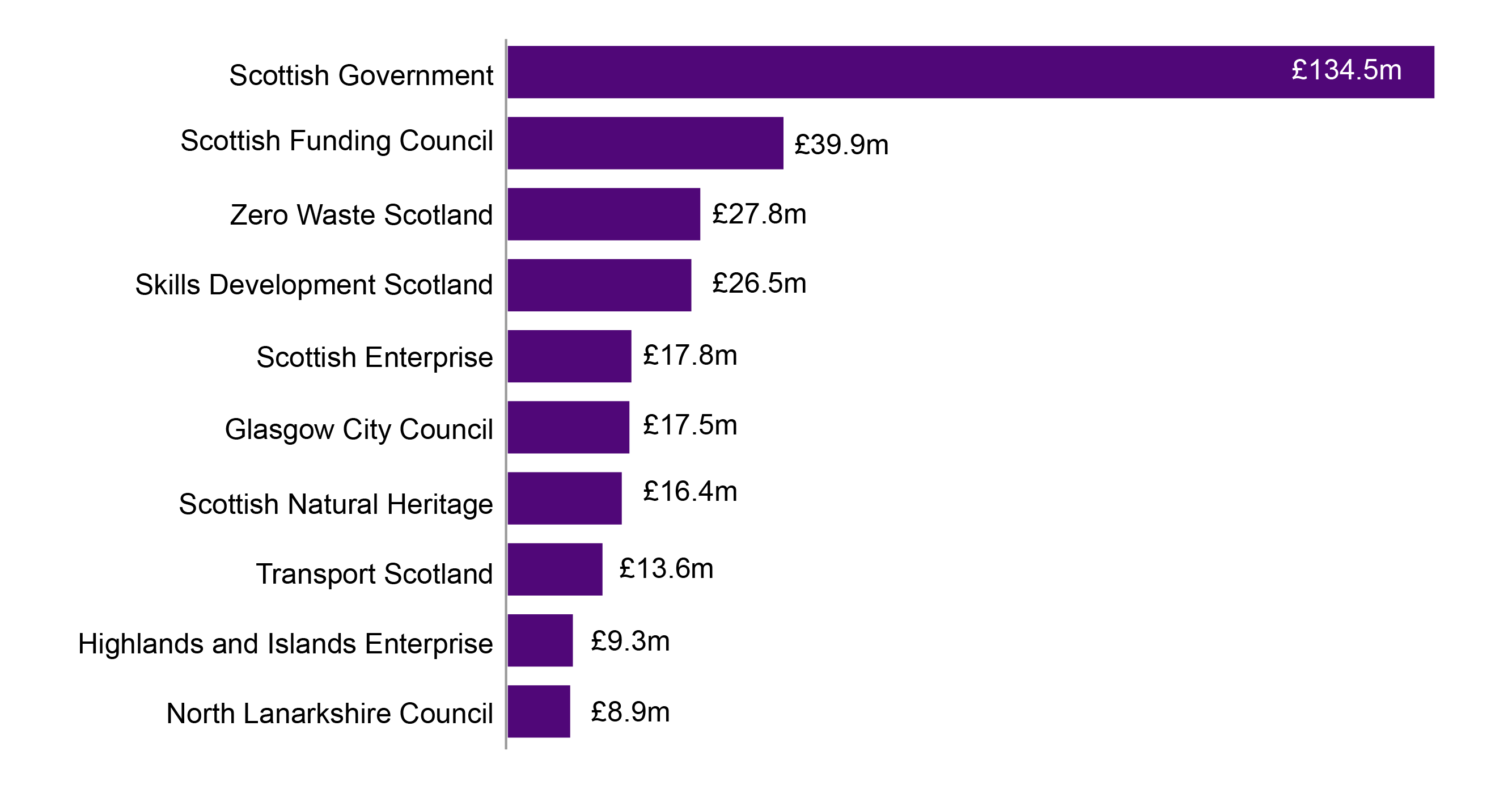
Making maximum use of the available structural funds
To access the full amount available to Scotland, the current round of structural funding needs to be committed to projects by the end of 2020. Funds committed by that time can be spent up to 2023. This is the case under the UK Treasury guarantee or the proposed Withdrawal Agreement as discussed below.
As of August 2018, 74% of the available funds had been allocated to strategic interventions, while 47% of the available funds had been committed to projects.
Only funds committed by the end of 2020 can be claimed, which leaves a period of 27 months from the time of writing to commit the remaining funds to projects. Projects must meet the programmes' rules and performance requirements. In addition, structural funding needs to be match-funded. This means that uncommitted structural funding still needs to be matched by the Scottish public sector if it is to be drawn down.
| Committed (£) | Committed (%) | Programme Total (£)* | |
|---|---|---|---|
| Highlands & Islands ERDF | 56,169,064 | 55% | 101,613,599 |
| Rest of Scotland ERDF | 164,943,448 | 51% | 324,955,193 |
| Highlands & Islands ESF | 26,001,002 | 35% | 73,817,595 |
| Rest of Scotland ESF | 101,907,762 | 39% | 258,710,589 |
| Youth Employment Initiative ESF | 48,950,205 | 59% | 82,496,100 |
| Total | 397,971,482 | 47% | 841,593,075 |
The precise amount of structural funds available will depend on the exchange rate, with a weakening pound having the effect of increasing the value of the structural funds (in pounds).
What will happen after Brexit?
Potential for transition to 2020
The draft Withdrawal Agreement states that the UK will continue to participate in all EU programmes financed by the Multiannual Financial Framework (MFF) 2014-20 until its closure. This includes the structural funds.
If a Withdrawal Agreement is agreed between the UK and EU on these terms, the current round of structural funding available under the MFF 2014-20 will continue under Union law.
"No-deal" scenario
If there is no Withdrawal Agreement finalised, new projects will not be able to access structural funds under MFF 2014-20. The implications for current operations is not certain. However, the UK Treasury and Scottish Government have provided a succession of guarantees on backstop funding.
In 2016, UK Treasury provided the following guarantee for all European Structural and Investment (ESI) funds, including the ERDF and ESF, to devolved governments:
Where the devolved administrations sign up to structural and investment fund projects under their current EU budget allocation prior to Brexit, the government will ensure they are funded to meet these commitments.
UK Government. (2016, October 3). Further certainty on EU funding for hundreds of British projects. Retrieved from https://www.gov.uk/government/news/further-certainty-on-eu-funding-for-hundreds-of-british-projects [accessed 7 September 2018]
A month later, the Scottish Government confirmed that it will pass on the UK Treasury's guarantees in full in Scotland:
The current guarantees cover all payments of contracts for EU structural funds, CAP Pillar 2/Scottish Rural Development Programme, European Maritime Fisheries Fund and projects funded directly by the EU… that are entered into before the UK leaves the EU – even if the payments extend beyond the date of Brexit… There are currently no guarantees for projects or proposals that might come forward after the UK leaves the EU.
Scottish Government. (2016, November 2). EU funds guaranteed. Retrieved from https://news.gov.scot/news/eu-funds-guaranteed [accessed 7 September 2018]
In a written statement to the UK Parliament on 24 July 2018 the UK Government extended its guarantee:
[UK] Treasury is extending the Government's guarantee of EU funding to underwrite the UK's allocation for structural and investment fund projects under this EU budget period to 2020.
UK Government. (2018, July 24). HM Government’s Guarantee. Retrieved from https://hansard.parliament.uk/Commons/2018-07-24/debates/18072456000018/HMGovernment%E2%80%99SGuarantee [accessed 7 September 2018]
The UK Government's no deal notices for the ERDF and ESF say that this guarantee will allow the Scottish Government to continue to sign new projects after Brexit until the end of 2020. The notices also state that existing arrangements for the structural funds will be maintained with some flexibility for simplification.
Proposals for a UK-wide replacement fund
At this time, the UK Government does not appear to be negotiating for access to structural funds after the proposed transition period.
The Conservative Party manifesto for the 2017 General Election committed to a UK-wide replacement for EU structural funds, called the UK Shared Prosperity Fund (UKSPF).4
On 24 July 2018, the UK Government provided an update via a written statement to the UK Parliament:5
"The objective of the UKSPF. The UKSPF will tackle inequalities between communities by raising productivity, especially in those parts of our country whose economies are furthest behind. The UKSPF will achieve this objective by strengthening the foundations of productivity as set out in our modern industrial strategy to support people to benefit from economic prosperity.
A simplified, integrated fund . EU structural funds have been difficult to access, and EU regulations have stopped places co-ordinating investments across the foundations of productivity. Simplified administration for the fund will ensure that investments are targeted effectively to align with the challenges faced by places across the country and supported by strong evidence about what works at the local level.
UKSPF in the devolved nations. The UKSPF will operate across the UK. The Government will of course respect the devolution settlements in Scotland, Wales and Northern Ireland and will engage the devolved administrations to ensure the fund works for places across the UK."
Consultation on proposals is expected in late 2018 and the UK Government has suggested that further details of the fund's operation and priorities will be announced following the UK spending review planned for 2019.
The role of the Scottish Government in the design of the fund in Scotland or the level of funding allocated to Scotland is not certain at this time.
Common Fisheries Policy
The Common Fisheries Policy (CFP) is the mechanism and set of rules for managing European fishing fleets and conserving fish stocks. The EU fund supporting the CFP is the European Maritime and Fisheries Fund (EMFF).
The EMFF co-finances the implementation of the CFP alongside projects focused on transitioning to sustainable fishing and aquaculture, creating new jobs, diversifying coastal economies and making it easier for applicants to access finance.
The Fund is worth €6.4 billion across the European Union between 2014 and 2020.
How are funds allocated across the EU and UK?
Each Member State is allocated a share of the total, based on the size of its fishing industry. The industry size is measured by:
the level of employment in the fisheries and marine and fresh water aquaculture sectors, including employment in related processing;
the level of production in the fisheries and marine and fresh water aquaculture sectors, including related processing; and
the share of small-scale coastal fishing fleet in the overall fishing fleet.1
The UK is allocated €243 million from the EMFF for the 2014-20 funding period.2
To allocate EMFF funding to devolved authorities, the UK chose to use broadly the same criteria to measure the size of regional fishing industries as described above.3 Scotland is allocated 44% (€108 million) of the total UK figure.4
How decisions on EMFF are made
The process starts with the EU regulations setting out the rules, along with some high-level ‘union priorities’ for the CFP. A partnership agreement covering the full suite of ESI funds is agreed by the Commission and the Member States. This agreement sets out at a high-level how the funds will be spent and defines the Managing Authority.
The Managing Authority produces an EMFF Operational Programme to set out in more detail the fund's management, objectives and programmes across 2014-20. Intermediate Bodies (IB) can be defined to manage regional programmes.
The EMFF is used to co-finance projects with other public funding sources.
The EMFF in Scotland today
The EMFF is the only European Structural & Investment (ESI) funding programme managed at a UK level, however significant responsibilities are delegated to the Scottish Government.
The UK's Partnership Agreement defines the UK Government's Marine Management Organisation (MMO) as the managing authority, and Marine Scotland as an 'intermediate body of the managing authority'.1
The MMO's Operational Programme sets out how the funds will be spent and defines UK-wide objectives, activities, targets and funding allocations.2 Marine Scotland has responsibility for the delivery of the Scottish element of the programme including the selection of projects and the payment and scrutiny of claims.
Marine Scotland is co-funded though the EMFF to implement the CFP in Scotland.
| UK allocation (€) | Scotland allocation (€) | Scotland allocation (£) | |
|---|---|---|---|
| Core - used for grant funding | 137,800,000 | 63,388,000 | 50,773,788 |
| Compliance/control costs | 45,192,561 | 19,884,726 | 15,927,666 |
| Data Collection | 52,441,314 | 20,871,642 | 16,718,186 |
| Storage (market intervention measures) | 2,370,890 | 1,090,609 | 873,578 |
| Integrated Marine Planning | 5,334,672 | 2,453,951 | 1,965,613 |
| Total | 243,139,437 | 107,688,928 | 86,258,831 |
Marine Scotland manages the award of funding programmes available to the fishing industry for projects that support CFP priorities.
The Marine Scotland EMFF funding programmes are:
Fishing vessel energy improvements and re-engining
Investments on board fishing vessels
Investments to shore based facilities
Partnerships & advisory services
Aquaculture, processing and marketing
Support internal partners
Marine environment and inland fishing
Community-led local development
Calculated in Sterling, Marine Scotland has awarded almost £42 million in funding to 492 projects as of May 2018.
| Union Priority | Sum of EMFF awarded (£) | Number of projects |
|---|---|---|
| 1 - Promoting environmentally sustainable, resource efficient, innovative, competitive and knowledge based fisheries | 21,801,000 | 336 |
| 2 - Fostering environmentally sustainable, resource efficient, innovative, competitive and knowledge based aquaculture | 9,604,000 | 40 |
| 3 - Fostering the implementation of the CFP | 0 | 0 |
| 4 - Increasing employment and territorial cohesion | 2,150,000 | 72 |
| 5 - Fostering marketing and processing | 8,329,000 | 44 |
| 6 - Fostering the implementation of the Integrated Maritime Policy | 84,000 | 1 |
| Total | 41,967,000 | 493 |
| Beneficiary | Description | EMFF grant | Total grant amount | Total project cost |
|---|---|---|---|---|
| Peterhead Port Authority | Extended Fish Market and Deepening of Inner Harbours | 3,750,000 | 5,000,000 | 15,350,713 |
| Scottish Aquaculture Innovation Centre | Driving sustainability and increasing capacity for Scottish Aquaculture | 1,721,323 | 2,295,097 | 2,295,097 |
| Orkney Islands Council | Pierowall Pier, Westray | 1,675,030 | 2,781,974 | 2,781,974 |
| Blueshell Mussels Limited | Specialist ultra efficient harvesting and seed deployment vessels and handling equipment | 1,501,619 | 2,002,158 | 4,004,316 |
| SFF Services Limited | Independent On-board Observer Scheme - Phase VI | 1,411,434 | 1,881,912 | 1,881,912 |
| Scottish Aqua Innovation Centre | Piloting non-medicinal interventions and operational innovation in Scottish aquaculture | 1,326,703 | 1,768,937 | 8,445,387 |
| Lerwick Port Authority | New Lerwick Fishmarket | 1,180,532 | 1,574,043 | 6,296,173 |
| University of St Andrews | Scottish Inshore Fisheries Integrated Data System (SIFIDS) | 1,132,835 | 1,510,446 | 1,510,446 |
| Seafood Scotland | Local Seafood Marketing project | 1,050,000 | 1,400,000 | 1,400,000 |
| Highland Harbour Council | Refrigeration and Discards Project Kinlochbervie | 1,027,805 | 1,370,406 | 1,370,406 |
What will happen after Brexit
If a Withdrawal Agreement is agreed between the UK and EU similar to the terms of the draft Agreement, the current EMFF available under the MFF 2014-20 will continue under Union law until the end of 2020.
If there is no withdrawal agreement finalised, the implications for access to the EMFF programme are not certain.
The EMFF is one of the ESI funds. The EMFF is therefore covered by the UK Treasury guarantee on backstop funding as described in the section on structural funds.
After 2020, the European Commission proposes to maintain a revised version of the EMFF in the next funding period 2021-27. The UK Government are not negotiating for access to the EMFF after 2020.
The UK Government's White Paper Sustainable fisheries for future generations states "We will consider whether and how to replace the EMFF". The paper goes on to say that any replacement to the EMFF would be consistent with the functioning of the UK internal market, that the UK Government intends to amend the existing grant-making powers in the Fisheries Act 1981 though its proposed Fisheries Bill and that the proposed UK Shared Prosperity Fund "will be important for coastal communities across the UK".1
There is no certainty at present on what might replace the EMFF, the role of the Scottish Government in the design of the fund or the way in which funding may be allocated to Scotland.
Competitive Funds
While the majority of EU funding is pre-allocated, competitive funds represent another way EU policies are implemented.
Organisations and occasionally individuals can apply directly to the European Commission to access grants to help them carry out projects that further EU policies in areas such as research, education and humanitarian aid. As a general rule, these programmes are transnational, which means that the participation of partners from more than one member state is required for the submission and implementation of a proposal. Grants rarely cover the whole cost of a project and generally require a level of co-financing.
Significant competitive funds relevant to Scotland include Horizon 2020, Erasmus+ and European Territorial Cooperation. These funds are explored in more detail below, with a brief explanation of other funds available in Annex A.
Horizon 2020
Horizon 2020 is the EU's main funding programme for research and innovation. Horizon 2020 seeks to coordinate and pool research efforts across Europe. It aims to leverage additional research, development and innovation funding and contribute to attaining research and development targets, including the target of 3% of GDP for research and development across the Union by 2020.
Horizon 2020 has a total budget of €76.4 billion for the period from 2014 to 2020.
As a competitive fund, project proposals are judged and ranked on the scientific excellence of the proposal, on how they will be delivered (implementation) and on the expected impact that the project will have. The UK has a strong track record of securing research funding. As of July 2018, 14.3% of funds allocated from Horizon 2020 have gone to UK organisations, putting the UK second across the EU by share of total funding.
The main recipients of Horizon 2020 funding are universities with 66% of Horizon 2020 funding at a UK level going to higher education institutions. Further types of organisations benefiting include business (19%), research organisations (6%) and other public bodies (5%).
Funding secured in Scotland
As of July 2018, Scottish organisations had secured almost €533 million worth of funding, representing 11.2% of the total UK funding. Universities are the largest recipient securing 73% of Scottish funding.
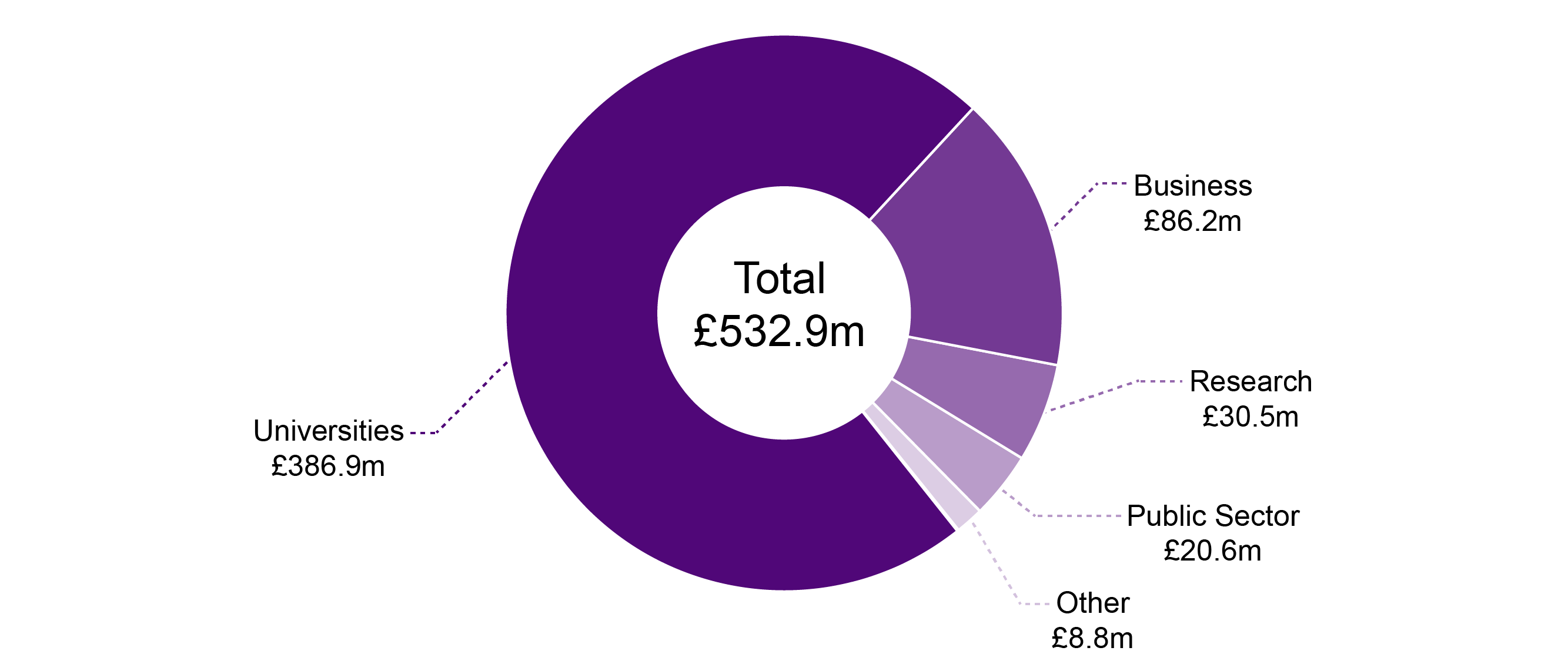
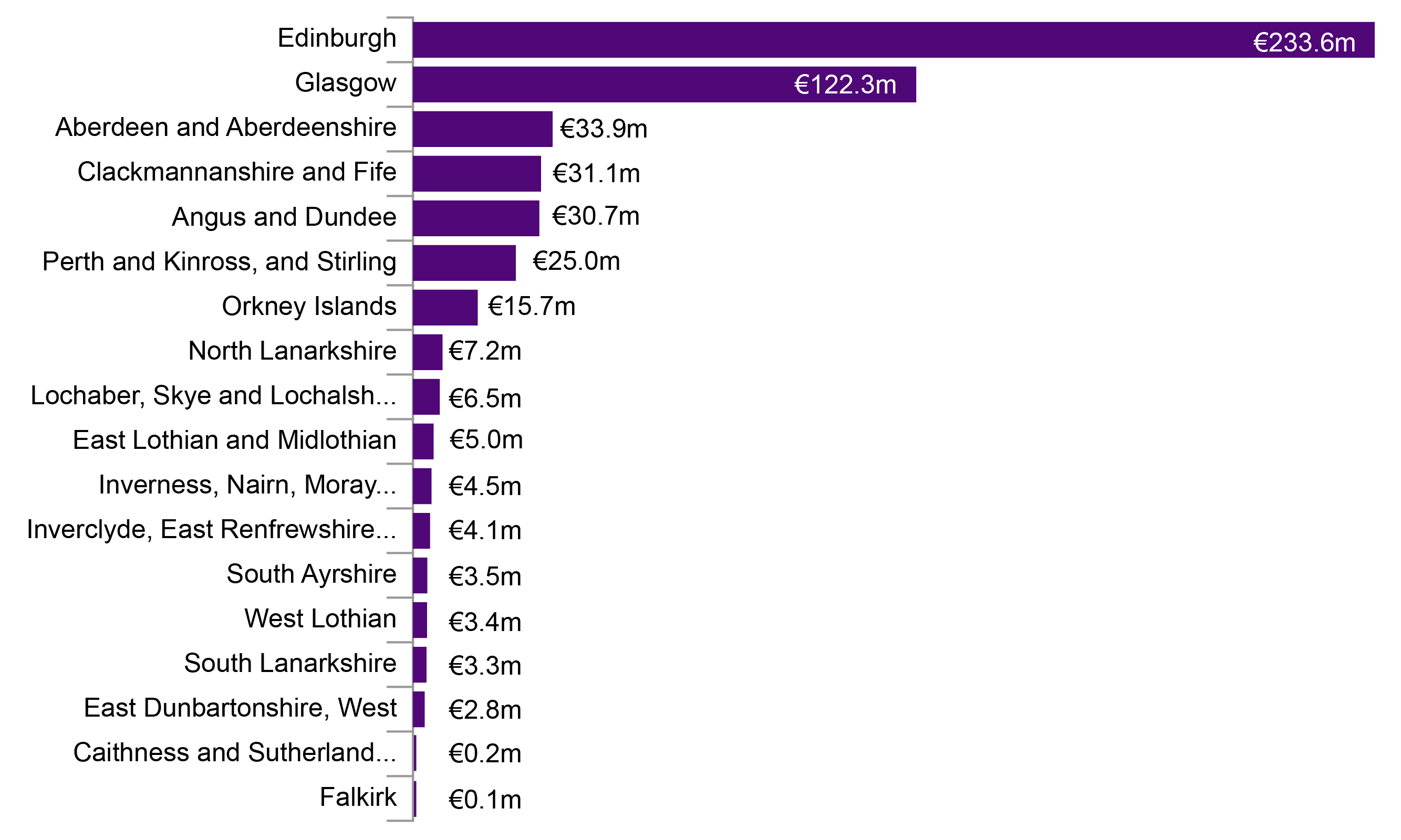
| Organisation | Total participations | EU funding (€ millions) | Ranking (by share of funding across EU) |
|---|---|---|---|
| University of Edinburgh | 257 | 171.9 | 8 |
| University of Glasgow | 147 | 74.2 | 43 |
| University of St Andrews | 56 | 31.2 | 118 |
| University of Strathclyde | 79 | 26.3 | 139 |
| University of Dundee | 50 | 24.1 | 147 |
| Heriot-Watt University | 43 | 23.7 | 148 |
| University of Aberdeen | 50 | 17.9 | 184 |
What will happen after Brexit?
If a Withdrawal Agreement is agreed between the UK and EU similar to the terms of the draft Agreement, the current Horizon 2020 programme will continue until 2020 under Union law.
If there is no withdrawal agreement finalised, the implications for access to the Horizon 2020 programme are not certain.
To address this scenario, the UK Treasury and Scottish Government provided a guarantee on backstop funding in 2016 for successful projects whose bids were submitted before the UK leaves the EU:
where UK organisations bid directly to the European Commission on a competitive basis for EU funding projects while we are still a member of the EU, for example universities participating in Horizon 2020, the Treasury will underwrite the payments of such awards, even when specific projects continue beyond the UK's departure from the EU.
UK Government. (2016, August 13). Chancellor Philip Hammond guarantees EU funding beyond date UK leaves the EU. Retrieved from https://www.gov.uk/government/news/chancellor-philip-hammond-guarantees-eu-funding-beyond-date-uk-leaves-the-eu [accessed 7 September 2018]
On 24 July 2018, the UK Treasury updated its guarantee to cover the period of the proposed transition:
The Treasury is also guaranteeing funding in the event of a no deal for UK organisations which bid directly to the European Commission so that they can continue competing for, and securing, funding until the end of 2020.
UK Government. (2018, July 24). HM Government’s Guarantee. Retrieved from https://hansard.parliament.uk/Commons/2018-07-24/debates/18072456000018/HMGovernment%E2%80%99SGuarantee [accessed 7 September 2018]
However, in a “no deal” scenario the UK would become a ‘third country’ and UK organisations could only continue to compete for funding from a more limited number of Horizon 2020 grants. This is covered in more detail in the UK Government's technical note on Horizon 2020 funding if there's no Brexit deal.
After 2020, the European Commission proposes that Horizon 2020 is replaced by a revised programme called Horizon Europe. The UK Government's white paper proposes an accord that:
provides for UK participation in EU research funding programmes… including Horizon Europe, the Euratom Research and Training Programme, the Joint European Torus (JET) project and ITER.
UK Government. (2018, July 12). White paper: The future relationship between the United Kingdom and the European Union. Retrieved from https://www.gov.uk/government/publications/the-future-relationship-between-the-united-kingdom-and-the-european-union [accessed 7 September 2018]
Under the existing regulations, 16 non-Member States have “associate country” status and are able to participate.4 These countries include Iceland, Norway, Turkey, Israel and Tunisia.5 The specific regulations for Horizon Europe are not yet agreed and any UK participation is subject to continued negotiations.
Erasmus+
Erasmus+ is an EU programme that aims to promote and modernise education, training, youth work and sport across Europe. Projects supported are intended to promote the movement of learners (students, trainees, apprentices, young people, volunteers) and staff (professors, teachers, trainers, youth workers) across national boundaries, as well as exchanging good practice, promoting young people's democratic participation and other outcomes.
Erasmus+ has a budget of €14.7 billion under the MFF 2014-20; two thirds of this is earmarked to fund opportunities for individuals to learn abroad.
An additional €1.68 billion is available through the EU's external action budget for funding actions with non-EU partner countries. Partner countries currently include 23 states neighbouring the EU such as Montenegro, Azerbaijan, Morocco and Russia. These countries are able to participate in the programme in a more limited way on the basis of bilateral agreements which include financial contributions.
The UK Government's Department for Education oversees the Erasmus+ programme in the UK. The British Council and Ecorys UK (a research and consultancy company) are jointly designated as the UK National Agency and they work in partnership to manage and deliver the programme.1
Across the first four years of the programme period (2014-2017), UK organisations have been awarded €507 million for 3,829 projects.
Funding secured in Scotland
Across the same four years (2014-2017), Scottish organisations were awarded €64.8 million for 658 projects. This represents 13% of the value of grants awarded to the UK.
| Projects | Grants awarded | |||
|---|---|---|---|---|
| number | share | € million | share | |
| England | 2,757 | 72% | 384 | 76% |
| Scotland | 658 | 17% | 65 | 13% |
| Wales | 187 | 5% | 29 | 6% |
| Northern Ireland | 224 | 6% | 28 | 6% |
| Total | 3,829 | 507 | ||
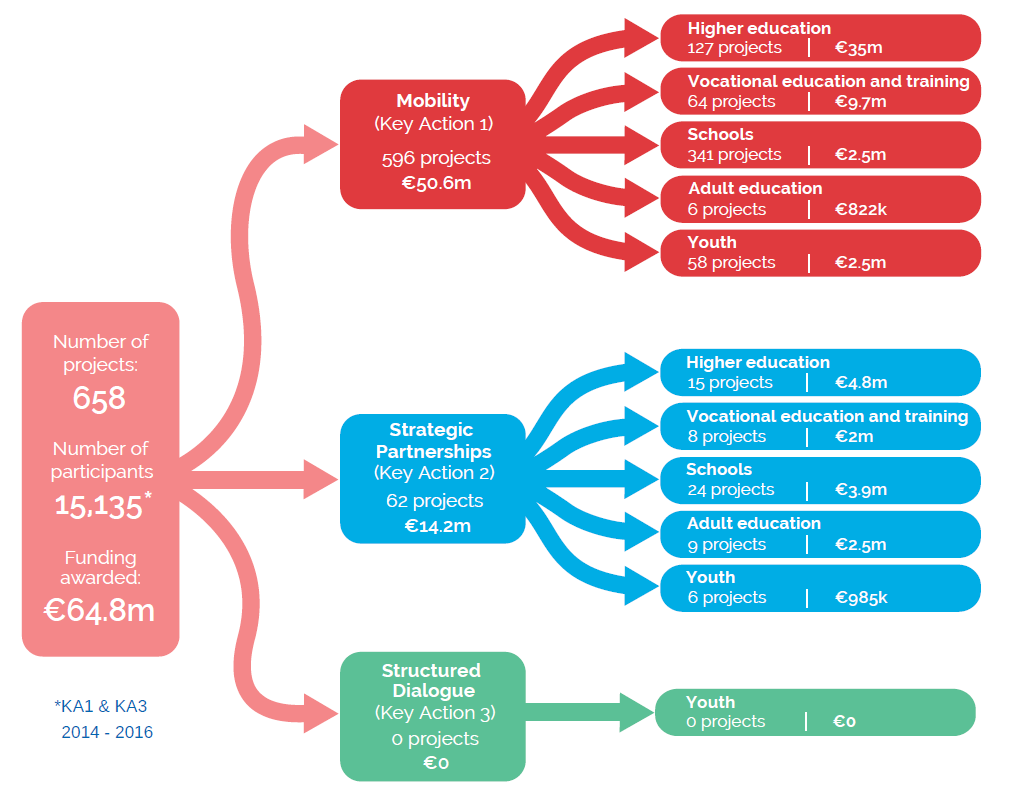
What will happen after Brexit?
If a Withdrawal Agreement is agreed between the UK and EU similar to the terms of the draft Agreement, the current Erasmus+ programme will continue until 2020 under Union law.
If there is no withdrawal agreement finalised, the implications for access to the current Erasmus+ programme are not certain. The Erasmus+ programme is covered by the same UK Treasury and Scottish Government funding guarantee as described for Horizon 2020. It is not clear how the guarantee would be operational in a "no deal" scenario where access for organisations to make new bids into Erasmus+ may not exist. The UK Government's notice on Erasmus+ in the UK if there's no Brexit deal indicates that an agreement would be needed to allow the UK organisations to continued to participate.
After 2020, the European Commission proposes that Erasmus+ continues with a significantly increased budget. The UK Government's white paper states that "The UK is open to exploring participation in the successor scheme".3 The UK's participation, presumably as a partner country, is subject to continued negotiations.
European Territorial Cooperation funds
In addition to the pre-allocated funds available for economic development in Scotland, a set of funds are available through the ERDF for territorial cooperation across borders. This European territorial cooperation (ETC) is commonly known as INTERREG.
The Highlands and Islands region has benefited from 46% of all ETC funding secured in Scotland during the current funding period.
| Funding Programme | Total funding to Scotland (€) |
|---|---|
| Cross-Border Programme for Northern Ireland, Border Region of Ireland & South Western Scotland (known as Interreg VA) | 22,846,971 |
| North West Europe Programme | 15,925,314 |
| North Sea Region V Programme | 7,214,451 |
| Northern Periphery & Arctic Programme | 6,006,699 |
| Atlantic Area Transnational Cooperation Programme | 4,415,002 |
| INTERREG Europe | 1,489,300 |
| URBACT III | 38,234 |
After 2020, the European Commission proposes a new generation of interregional and cross-border cooperation programmes. The proposed EU regulation states that non-EU Member States are able to participate.1 This means that regions of the UK can still participate in ETC subject to negotiations on the UK's future relationship with the EU.2
European Investment Bank Group
The funding programmes described so far are part of the MFF 2014-20. However, some EU funding comes to Scotland from outwith the EU budget though European Investment Bank Group financing.
European Investment Bank lending
The European Investment Bank (EIB) is an investment bank that is jointly owned by EU Member States. The Bank borrows money on capital markets and lends it on favourable terms to projects that support EU objectives. It is the world's largest multilateral lending institution and plays a role in large-scale infrastructure projects across the UK.
The EIB describes its lending as:
focused on the EIB's public policy goals, namely innovation, SMEs and mid-cap financing, infrastructure and environment in addition to its two overarching policy goals related to EU social and economic cohesion and climate action.
European Investment Bank. (2018, May 4). Financial Report 2017. Retrieved from http://www.eib.org/en/infocentre/publications/all/financial-report-2017.htm [accessed 7 September 2018]
Approximately 90% of its lending goes to projects in EU Member States.
The UK provides 16.1% of the EIB's capital. The EIB's Financial Report 20171 reports the UK's ‘paid-in’ capital as worth €3.5bn. In addition, the EIB has a significant reserve of subscribed unpaid capital it can call upon from Member States if necessary to meet the Bank's obligations – this amounts to €35.7bn of so called ‘callable capital’ from the UK.
New lending to projects in the UK in 2017 (measured by new signatures) was worth €1.8bn, representing 3% of the total. This proportion is significantly lower than previous years.
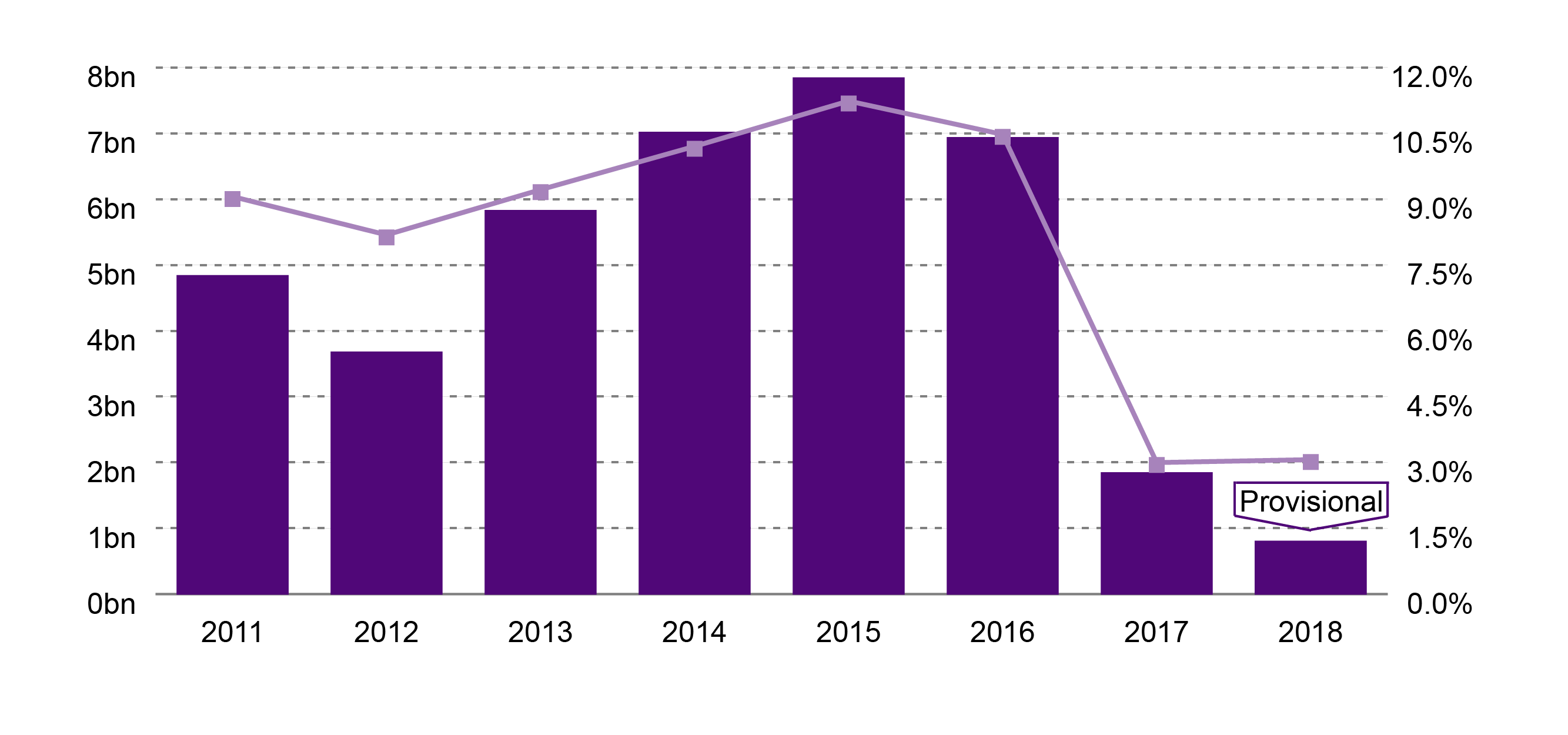
Lending in Scotland
Lending to projects in Scotland signed since 2016 includes:
Beatrice Offshore: construction of Beatrice windfarm, Scotland’s largest offshore windfarm 14 km off the Caithness coast. EIB lending worth €682 million. The Beatrice project is also the only Scottish project to have received funding from the European Fund for Strategic Investments.
SSE Caithness-Moray submarine power transmission: a major reinforcement of the electricity transmission network to improve connections between wind, wave and tidal renewable energy schemes and the national power network. EIB lending worth €611 million.
Wheatley Group energy efficient housing: the retrofitting of existing social housing to meet energy efficiency standards, the construction of new low-carbon social housing and the provision of housing and integration for refugees. EIB lending worth €210 million.
The EIB publishes data on every loan, but not at a Scotland level. SPICe have used the EIB database to identify loans made since the start of 2016 for projects evidently within Scotland. This may not be a complete list. In addition, some projects not included because they are primarily located outwith Scotland can be expected to have an impact on Scotland's economy.
Table 11 identifies six projects which together have received a total loan value of €2.0 billion. This represents 21% of the total loan value signed in the same period for the whole of the UK.
| Name | Sector | Signature Date | Signed Amount (€) |
|---|---|---|---|
| SSE CAITHNESS MORAY POWER TRANSMISSION | Energy | 29/03/2016 | 382,409,178 |
| JHF SCOTLAND - AMBER SPRUCE 2 LLP (L) | Credit lines | 23/12/2016 | 23,297,749 |
| ABERDEEN HARBOUR EXPANSION | Transport | 20/06/2016 | 258,481,422 |
| BEATRICE OFFSHORE | Energy | 20/05/2016 | 292,177,436 |
| BEATRICE OFFSHORE | Energy | 20/05/2016 | 389,569,915 |
| UNIVERSITY OF EDINBURGH CAPEX PROGRAMME | Education | 17/02/2016 | 256,953,813 |
| SSE CAITHNESS MORAY POWER TRANSMISSION | Energy | 14/03/2017 | 114,203,488 |
| SSE CAITHNESS MORAY POWER TRANSMISSION | Energy | 14/03/2017 | 114,203,488 |
| WHEATLEY - ENERGY EFFICIENT HOUSING IN SCOTLAND | Industry | 13/06/2018 | 115,349,734 |
| WHEATLEY - ENERGY EFFICIENT HOUSING IN SCOTLAND | Urban development | 13/06/2018 | 94,377,055 |
| Total | 2,041,023,276 |
European Investment Fund
The EIF is a specialist provider of risk finance to small and medium-sized enterprises (SME) across Europe.
The EIF’s shareholders are the European Investment Bank (EIB), the European Union and a number of public and private financial institutions. The EIB and EU together hold 88% of the EIF’s shares.
The EIF works though a range of financial intermediaries in Member States and other neighbouring countries to design and provide financial products to SMEs. UK-based financial intermediaries include Barclays Bank, Fredericks Foundation and Scottish Equity Partners.
Together the EIB and the EIF form the European Investment Bank Group.
A specific scheme for Scottish SMEs was established in 2017 called the Scottish-European Growth Co-Investment Programme. This programme is managed by the EIF and financed with £50 million in financial transactions from Scottish Enterprise and £50 million from the EIF. Scottish Enterprise holds EIB shares representing 0.1% of the total.1
What will happen after Brexit?
Article 308 of the Treaty on the Functioning of the EU, states that the members of the EIB shall be the Member States.
If a Withdrawal Agreement is finalised between the UK and EU similar to the terms of the draft Agreement, then after withdrawal the UK and UK-based projects will not be eligible for funding from the EIB group reserved for Member States.
Any funds signed before the UK's withdrawal will continue on the same basis as they were approved. The UK's paid-in capital will be refunded in twelve yearly instalments and the UK will remain liable for loans made during the time it was a shareholder of the EIB and for its proportional share of uncalled capital. The EIB's accumulated profits will not be disbursed to the UK.
If there is no withdrawal agreement finalised and the UK leaves the EU, under Union law it can no longer be a member of the EIB. The implications of this scenario are not certain.
Continued relationship?
The UK-EU Joint Report on the first phase of negotiations states that the UK wishes to explore "continuing arrangements" between the UK and EIB in the second phase of the negotiations.1 The UK Government's White Paper published in July 2018 however, does not detail the UK position on any future relationship with the EIB Group.2
While the EIB does provide roughly 10% of its loans to projects in countries outside the EU, this lending is governed by mandates which support EU development and cooperation policies in partner countries. Any continued lending to the UK would have to be agreed by the EIB’s board of governors which comprises of finance ministers from all EU Member States. 3
Annex A - other EU funding under the MFF 2014-20
The 2014-2020 multi-annual financial framework also provides funding for some other European programmes. A number of these are detailed in this section.
The Scottish EU Funding Portal provides a single source of information on EU funding programmes for which Scotland is eligible. Examples of Scottish projects funded by these programmes are also available through the portal database.
Asylum, Migration and Integration Fund (Security and Citizenship)
The Asylum, Migration and Integration Fund focuses on people flows and the integrated management of migration. The programme is worth €3.1 billion and the UK is allocated €370m for use on UK priorities in the field of migration and integration.
Cohesion Fund (Smart and Inclusive Growth)
The Cohesion fund aims at reducing economic and social shortfall, as well as stabilising the economy of Member States whose Gross domestic product (GDP) per inhabitant is less than 90% of the EU average. The UK does not fall under this definition. The programme is worth €74.9 billion (with €11.3 billion being allocated towards the Connecting Europe facility). The UK Government has published a notice on Connecting Europe Facility energy funding if there's no Brexit deal.
Common Foreign and Security Policy (Global Europe)
The role of the EU's foreign and security policy is to preserve peace and strengthen international security; to promote international cooperation; and to develop and consolidate democracy, the rule of law and respect for human rights and fundamental freedoms. The programme is worth €2.3 billion.
Copernicus (Smart and Inclusive Growth)
Copernicus is a European system for monitoring the Earth. It ensures the regular observation and monitoring of Earth sub-systems, the atmosphere, oceans, and continental surfaces, and provides reliable, validated and guaranteed information in support of a broad range of environmental and security applications and decisions. The programme is worth €4.3 billion.
Competitiveness of Enterprises and SMEs (COSME) (Smart and Inclusive Growth)
The COSME programme supports the competitiveness, growth and sustainability of EU's enterprises, in particular SMEs, and promoting entrepreneurship. To reach these goals, the programme eases SME's access to finance by providing loan guarantees and risk-capital. It facilitates access to new markets inside and outside the EU and reduces the administrative burden on SMEs. The total budget for COSME is €2.3 billion.
Creative Europe (Security and Citizenship)
The Creative Europe programme supports European cinema and cultural and creative sector. It supports tens of thousands of artists, cultural professionals and cultural organisations in the performing arts, fine arts, publishing, film, TV, music, interdisciplinary arts, heritage, and the video games industry, allowing them to operate across Europe, to reach new audiences and to develop the skills that are needed in the digital age. By helping European cultural works to reach new audiences in other countries, the programme contributes to safeguarding and promoting Europe's cultural and linguistic diversity.
The programme is worth almost €1.5 billion. Across 2014 to 2017, €74 million has been awarded to UK-based cultural and creative organisations and audiovisual companies.1 Some non-EU countries are able to contribute to and participate in the Creative Europe programme under the rules of the programme.2
Development Cooperation Instrument (Global Europe)
The Development Cooperation Instrument focuses on combating poverty in developing countries. The programme is worth €19.6 billion.
Employment and Social Innovation Programme (Smart and Inclusive Growth)
The Employment and Social Innovation Programme supports Member States efforts in the design and implementation of employment and social reforms at European, national as well as regional and local levels by means of policy coordination and the identification, analysis and sharing of best practices. The programme is worth €919.4 million.
European Instrument for Democracy and Human Rights (Global Europe)
The European Instrument for Democracy and Human Rights provides support for the promotion of democracy and human rights in non-EU countries. The programme is worth €1.3 billion.
European Neighbourhood Instrument (Global Europe)
The European Neighbourhood Instrument promotes enhanced political cooperation and progressive economic integration between the Union and its neighbouring countries. The programme is worth €15.4 billion.
Food and Feed (Security and Citizenship)
The new animal and plant health programme aims at strengthening the enforcement of health and safety standards for the whole agri-food chain. The package of measures provide a modernised and simplified approach to the protection of health and more efficient control tools to ensure the effective application of EU agri-food chain rules. The programme is worth €1.9 billion.
Galileo (Smart and Inclusive Growth)
The Galileo programme is Europe's initiative for a state-of-the-art global satellite navigation system, providing a highly accurate, guaranteed global positioning service under civilian control. The fully deployed system will consist of 30 satellites and the associated ground infrastructure. Galileo will be inter-operable with GPS and GLONASS, the two other global satellite navigation systems. The programme is worth €7.1 billion. The UK Government has published a notice on Satellites and space programmes if there's no Brexit deal.
Health (Security and Citizenship)
The EU Health Programme is about fostering good health in Europe by encouraging cooperation between Member States to improve the health policies that benefit their citizens. The programme is worth €449.4 million.
Humanitarian Aid (Global Europe)
The aim of the EU humanitarian aid policy is to provide assistance, relief and protection to people outside the EU victims of natural or man-made disasters. The programme is worth €6.6 billion. The UK Government has published a notice on Delivering humanitarian aid programmes if there's no Brexit deal.
Instrument for Pre-accession Assistance (IPA II) (Global Europe)
The Instrument for Pre-Accession provides financial support to the enlargement countries in their preparations for EU accession. The programme is worth €11.7 billion.
Instrument contributing to stability and peace (Global Europe)
The Instrument contributing to Stability and Peace (IcSP) is one of the key external assistance instruments that enable the EU to take a lead in helping to prevent and respond to actual or emerging crises around the world. The programme is worth €2.3 billion.
Internal Security Fund (Security and Citizenship)
The Internal Security Fund supports the implementation of the Internal Security Strategy and the EU approach to law enforcement cooperation, including the management of the union's external borders. The programme is worth €3.8 billion. The UK does not participate in this fund.
ITER (Smart and Inclusive Growth)
ITER is an international collaborative project (EU, US, China, Japan, India Russia, South Korea) to demonstrate the potential of nuclear fusion as an energy source. The programme is worth €3 billion. UK Government has published a notice on Nuclear research if there's no Brexit deal.
Justice Programme (Security and Citizenship)
The Justice programme aims to make sure that EU legislation in civil and criminal justice is effectively applied. It helps ensure proper access to justice for people and businesses in cross-border legal cases in Europe and supports EU actions to tackle drugs and crime. The programme is worth €377.6 million.
LIFE Programme
The Life Programme aims at improving the implementation of EU environment and climate policy and legislation. The programme will contribute to the shift towards a resource-efficient, low-carbon and climate resilient economy, to the protection and improvement of the quality of the environment and to halting and reversing biodiversity loss.
The programme is worth €3.5 billion. Since 2014, twelve LIFE projects have been awarded with Scotland listed as one of the benefiting regions on the LIFE project database, including projects on invasive grey squirrels, inland shipping and electronic equipment recycling. The UK Government has published a notice on Funding for UK LIFE projects if there's no Brexit deal.
Macro-financial Assistance (Global Europe)
Macro-financial assistance is an exceptional EU crisis response instrument. It provides loans and grants to EU neighbours dealing with serious, but generally short-term, balance-of-payments or budget difficulties. It is conditional and complements assistance by the International Monetary Fund. The programme is worth €564.6 million.
Nuclear decommissioning assistance programmes (Smart and Inclusive Growth)
Nuclear decommissioning assistance programmes finance the decommissioning of some nuclear installations in Bulgaria, Lithuania and Slovakia. The programme is worth €1.6 billion.
Partnership Instrument (PI) (Global Europe)
The overall objective of the Partnership Instrument is to advance and promote EU interests by supporting the external dimension of internal policies (e.g. competiveness, research and innovation, migration) and to address major global challenges (e.g. energy security, climate change and environment). The programme is worth €954.8 million.
Rights, Equality and Citizenship (Security and Citizenship)
The programme will help to make people's rights and freedoms effective in practice by making them better known and more consistently applied across the EU. The programme is worth €439.4 million. Iceland and Liechtenstein participate alongside EU Member States.
Youth Employment Initiative (Smart and Inclusive Growth)
The Youth employment initiative supports young people not in education, employment or training in the Union's regions with a youth unemployment rate in 2012 at above 25%. The initiative focuses on integrating these young people into the labour market. The programme is worth €3.2 billion. In Scotland, this has been administered as part of the structural funds.